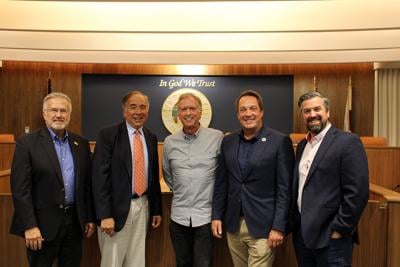San Clemente city officials discussed the urgent need to increase the city’s revenue streams to fund major capital projects during the Long Term Financial Plan item at the City Council meeting on Tuesday night, March 19.
Although staff indicated the city will have a balanced budget for Fiscal Year 2024-2025, and City Manager Andy Hall added San Clemente could continue operations indefinitely under the current structure, he said they’d be missing out on fulfilling resident desires without any action.
In addition to directing staff to complete various money transfers, the council unanimously voted to direct staff to explore additional revenue streams.
Councilmember Rick Loeffler described the situation on Tuesday as “pretty concerning,” noting that as the number of home transactions have decreased in recent years, thus reducing the number of property reassessments and significant hikes on property taxes, the city won’t be able to rely on property-tax revenue in the future the way it currently does.
“It looks like that difference between revenue and expenditures is going to be an even wider gap going into the next couple of years,” Loeffler said. “We’ve got to figure this out.”
Brian Brower, Administrative Services Director, told the council that the city’s operating position—calculated by subtracting operating expenditures from operating revenue—is positive but declining, as is the city’s fund balance.
The General Fund is stable, and revenues are healthy and increasing, Brower added, but expenditures are increasing at a higher rate than revenues.
Regarding financial trends city staff have analyzed from the city’s previous annual reports from FY2019 to FY2023, property-tax revenues were identified as positive and continuing to impress. However, Brower said sales-tax revenues and elastic revenues, both elements driven by the economy, have changed from a previously favorable trend to favorable with caution as sales-tax income has decreased since the pandemic.
Staff forecasted revenue challenges that will impact San Clemente’s ability to fund long-term capital projects, exacerbated with the recent losses of various sources.
With a built-out city, there are less developer impact fees coming in, which are charged to each new dwelling and can be used to construct new city facilities. Additionally, the city has lost out on $2.3 million each year since the expiration of the Clean Ocean Fee in 2021, a fee that affected property owners, and the dissolution of the state’s Redevelopment Agencies has eliminated another $2.5 million annually in tax increment financing.
While monies from those sources was often targeted to specific line items, the loss of those sources has placed more pressure on San Clemente’s General Fund, said Brower.
New revenue streams would have to be approved by San Clemente residents, but the city could implement an increase on the Transient Occupancy Tax (currently 10% on all lodging within the city), parcel assessments, or an increase in sales tax.
Like all other South Orange County cities and the county itself, San Clemente has a 7.75% sales tax rate, from which 6% goes back to the state of California. By adding 1% to the rate, the city could see another $13 million annually in revenue, according to staff.
Brower added the city will also aggressively pursue grant writing in the coming year, the city foresees economic development with new commercial and hotel projects, and that the city will consider leases and concessions of city facilities.
The picture painted by staff was “rather stark,” Mayor Victor Cabral said, adding San Clemente could find itself in financial trouble.
Regarding determining residents’ appetite for an increased sales tax or other measure, City Manager Hall said staff will soon survey the community and provide information about whether to pursue a ballot measure in the upcoming November election.
“It’s been made very clear to us that our residents are very, very interested in protecting our coast and our coastline,” Hall said of preliminary feedback from residents. “They may be interested in additional revenues, as long as those are targeted for the improvements that need to be made to increase the sand at the beach, take care of the pier, (and) take care of the beach trail.”
The U.S. Army Corps of Engineers is looking for funding to pay for additional costs as it looks to resume the San Clemente Shoreline Project, Hall added. The city has also worked with Rep. Mike Levin’s office to find federal funding, but the burden may fall on the city itself.
“We hope that’s not the case, (the Army Corps has) told us all along they believe they’re going to be able to find the money, but I think we’re going to have to be realistic about the fact that the sand has got to go forward,” said Hall. “... If we have to come up with some ways to pay for that, we’re going to do it.”
To have the wide, sandy beaches residents desire, staff anticipates the city will need to generate $10 million per year to properly fund the Shoreline Project during its six-year increments and the Sand Compatibility Opportunistic Use Program (SCOUP).
Under current revenues, however, the city won’t have that money, prompting Cabral to say the city must begin exploring revenue sources.
“It’s something that we have to have a conversation with the community (about) and get buy-in from the community,” said Cabral.


